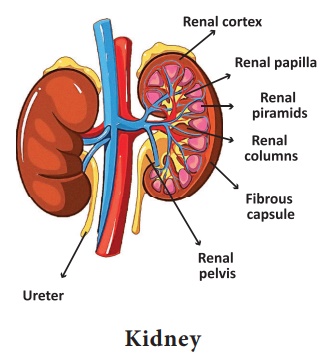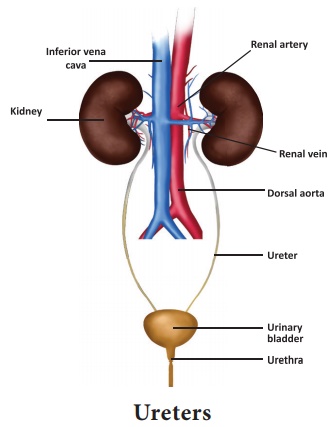Chapter: 12th Nursing : Chapter 1 : Human Anatomy and Physiology
Urinary system
Urinary system
Introduction
Urinary system also known as the renal system consist of the
kidneys, ureters, bladder, and urethra. The purpose of the urinary system is to
eliminate the excess water from the body, regulate blood volume and blood
pressure, control and regulate the level of electrolytes and blood PH.
The parts of the urinary system
• Kidneys
• Ureters
• Bladder
• Urethra
Kidneys
The kidneys are bean shaped bilateral urinary organs that lie in
the upper abdominal area in close proximity to the stomach and liver. The two
main layers of the kidney are the medulla and the renal cortex. The medulla is
the inside portion of the kidney and the cortex is the outer layer of the
kidney. The kidneys are made up of millions of nephrons, the primary
functional unit of the kidney.

Ureters
The bilateral ureters connect the pelvis of each kidney to the
bladder. The ureters consist of smooth involuntary muscle which serves as the
conduit of urine from the kidneys into the bladder.

Bladder
The bladder is the muscular organ that serves as the collection
and retention vessel which temporarily holds and retains urine prior to
urination. A normal urinary bladder can hold up to 800 milliliters of urine.
Urethra
Urethra transports urine from the bladder to the outside of the
body. This image shows (a) a female urethra and (b) a male urethra.
The urethra is the opening through which the urine passes out.
The male gender has two urethral sphincters to control both the
passage of urine and sperm and the female gender has only one urethral
sphincter to control the flow of urine only.
Physiology Of Urinary System
The functional unit of the urinary system is the nephron. The
actual filters are tiny structures called nephron and each kidney is made up of
one million nephrons. A nephron is made up of two parts, a cluster of
capillaries called glomerulus, and a long fine tube. The nephrons are doing the
following functions.

Filtration
Filtration occurs when the circulating blood passes through the
kidney where the removal of proteins and other cellular particles. The ultra
filtrate becomes urine after reabsorption and secretion.
Re absorption
Reabsorption occurs after filtration, entails the re-entry of some
particles and molecules from the ultrafiltrate back into the blood for future
use.
Secretion
Secretion is the opposite of reabsorption which entails the
movement of wastes and other molecules into the urine from the blood after it
is processed by the kidney.
The process of urine production
The entry of blood into the kidneys → filtration of blood → ultra filtration → Re absorption → Secretion → Excretion of urine
Kidney physiologically prompts the secretion of Antidiuretic
hormone and Aldosterone and production of enzymes like Renin and Angiotensin II
Functions of the urinary system
·
Eliminates wastes from the body
·
Manages and controls the homeostasis of the body in terms of its
pH or acid-base balance
·
Manages and controls the homeostasis of the body in terms of its
electrolytes and electrolyte balance
·
Manages and controls the blood pressure
·
Stores urine until voiding is prompted
·
Enables the process of urination
·
Remove wastes like urea and ammonia from the blood
·
Manage and control the fluids and fluid balance in the body by
holding or retaining water and releasing and removing water from the blood
stream
·
Serve with endocrine functions such as the production of
erythropoietin and calcitriol which are needed for the production of red blood
cells and the reabsorption of calcium, respectively.
Disease related to urinary system
·
Urinary tract infection
·
Urolithiasis
·
Nephrolithiasis
·
Renal failure
·
Renal cysts
·
Glomerulonephritis
·
Cancers of the urinary tract
·
Dialysis
Related Topics